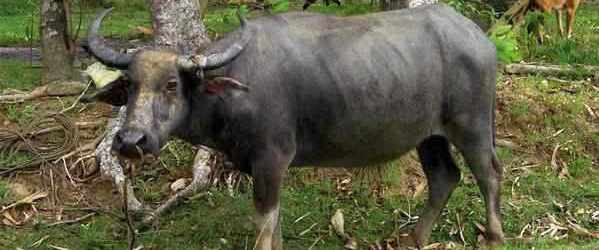
Many first time visitors to the Philippines will often see a statue of the Philippines National Animal, the carabao, in public parks and plazas. The carabao is a water buffalo but many locals refer to it simply as a buffalo. In this article, I will be referring to the carabao as a buffalo.
In the countryside, which is often referred to as the province, owning a buffalo is a status symbol and the more buffalo one owns, the higher their regard in status. The buffalo is still used this very day in the Philippines as a farm work animal. Some even use the buffalo as a means of local transportation! In the province where our farm is located, I often see someone riding on the back of a buffalo and there is also a cart that is pulled by a buffalo. Yep, it is called a buffalo cart. Even in the city limits of Bacolod, one can still see a buffalo and buffalo carts, especially on the south side of Bacolod City.
Buffalo in Philippine Culture
It has been said that the buffalo represents the Filipino ideas, characteristics, culture and traditions. In some respects, I see this with the hard work and patience that is so characteristic of many Filipinos. The buffalo will work hard and long in the hot sun but most of them maintain their patience. However, the buffalo looks forward to getting in the water and covering itself in mud when it is resting. Covering with mud is the favorite activity of the buffalo and this must be allowed on a regular basis to keep the buffalo happy. With its large size and horns, we do not want an unhappy buffalo, now do we?
It is not uncommon for those living and working in the city to buy a buffalo calf in the province for a relative to raise and then sell it for profit. There are normally little expenses raising a buffalo as long as there is a place for them to graze. The average selling price for an adult buffalo in our area of the Philippines is P25,000-P30,000. On a few occasions, I have heard of a really magnificent buffalo selling for P35,000, since it is of excellent stock.
The buffalo is often seen in paintings, sculptures, and in forms of other arts and crafts, sold as handicrafts.
Way back in 1986, I bought ground buffalo meat at a local supermarket in Manila! The buffalo meat made fabulous burgers. This was long before I had actually seen a live buffalo and nowadays, I would not eat buffalo. I never eat one of our free range chickens, either. There is a local Philippine brand of corned beef that lists buffalo meat and beef as the main ingredients.
Many Filipinos consider their buffalo a pet and a best friend. Many children in the province grew up with buffalo, so they consider them an important part of the family and why not? Buffalo are usually not dangerous but woe be unto the one who beats them and abuses them. There was one man in our village who was known to be sadistic to his buffalo but one day, the buffalo snapped and gored him. That was the end of the man! DOA. Can we say a buffalo never forgets?
The buffalo is also an instrument of humor in the Philippines. One journalist cartoonist uses his drawing of a buffalo to deliver his thought of the day, as if the buffalo is speaking it. Buffalo English! A humorous play on English words is sometimes referred to as Buffalo English. I have also heard the term used to describe poor English speaking Filipinos in a critical manner and I would avoid telling a local that they speak Buffalo English!
Since we have buffalo on the farm and we often see buffalo in the city where we live, I can honestly say that I live where the buffalo roam.